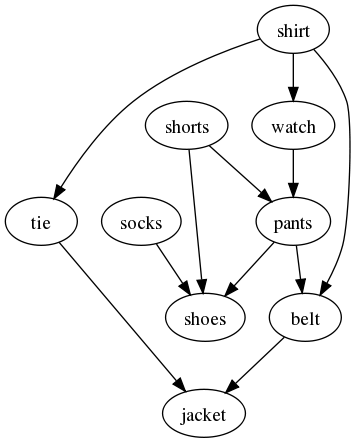26012010 Haskell
sieve (x:xs) = x : sieve [y|y<-xs,y `mod` x /= 0]
prime = sieve [2..]
26012010 Haskell
sieve (x:xs) = x : sieve [y|y<-xs,y `mod` x /= 0]
prime = sieve [2..]
25012010 Haskell
fglを使えばよい。
import Data.Graph.Inductive
import Data.Graph.Inductive.Example
import Data.Graph.Inductive.Graphviz
m486 :: NodeMap String
m486 = fromGraph clr486
t1 :: Gr String ()
t1 = insMapEdge m486 ("shirt", "watch", ()) clr486
t2 :: Gr String ()
t2 = insMapEdge m486 ("watch", "pants", ()) t1
main = do putStrLn $ graphviz t2 "test" (0,0) (0,0) Portrait
これはDOT言語で出力される。
digraph test {
margin = "0"
page = "0.0,0.0"
size = "0.0,0.0"
rotate = "0"
ratio = "fill"
1 [label = "shorts"]
2 [label = "socks"]
3 [label = "watch"]
4 [label = "pants"]
5 [label = "shoes"]
6 [label = "shirt"]
7 [label = "belt"]
8 [label = "tie"]
9 [label = "jacket"]
1 -> 4
1 -> 5
2 -> 5
3 -> 4
4 -> 7
4 -> 5
6 -> 3
6 -> 8
6 -> 7
7 -> 9
8 -> 9
}
pngで出力したいときにはdotに渡す。
$ ./gvtest | dot -Tpng > gvtest.png

参考
24012010 Haskell
プログラム・プロムナードのRubicキューブと置換の乗算を読んで2X2のソルバーを書いていたんだけど、巡回とねじりを覚えれば基本的に解けるのでリアルのほうを揃える方に夢中になってしまった。

*Main> prodPerm [e,t,t,e,s',b,b,s,e',t,t,e,s',b,b,s,e',e']
[[TSW,WTS,SWT],[TES,EST,STE]]
*Main> prodPerm [e,e,s,s,e',n',e,s,s,e',n,e']
[[STE,WTS,ETN],[EST,SWT,NET],[TES,TSW,TNE]]
23012010 Haskell
プログラム・プロムナードのRubicキューブと置換の乗算を読んでいたら、文字のローテションをしたいときにcycleを使っているのを見つけた。
import List
shift n c xs = case elemIndex c xs of
Nothing -> c
Just i -> cycle xs !! (i + n)
こんな感じ。
*Main> shift 1 'y' ['a'.. 'z']
'z'
*Main> shift 1 'z' ['a'.. 'z']
'a'
*Main> shift 1 ' ' ['a'.. 'z']
' '
これを使えばプログラミングHaskellのシーザー暗号は次のように書ける
import List
chrs = ['a'..'z']
shift n c xs = case elemIndex c xs of
Nothing -> c
Just i -> cycle xs !! (i + n)
encode n xs = [shift n x chrs | x <- xs]
実行
*Main> encode 3 "haskell is fun"
"kdvnhoo lv ixq"
22012010 Haskell
UDPとTCPでsyslogサーバとクライアント作って通信させる。
 Real World Haskell―実戦で学ぶ関数型言語プログラミング
Real World Haskell―実戦で学ぶ関数型言語プログラミング28章はSTMだけどこれはJava並行処理プログラミング読んでからにしよう。
これで一通り読んだので、そのうちもう一度読む。二周目は練習問題解きながら。
22012010 Haskell
HaXmlとHDBCを使ってXMLの構文解析とSQLiteのデータベース操作を組み合わせてpodcastのダウンローダーをつくるというなかなか楽しい章だが、このまえSQLAlchemyの本読んでたから、SQL文を直接埋め込むのはなんか面倒くさかった。
 Real World Haskell―実戦で学ぶ関数型言語プログラミング
Real World Haskell―実戦で学ぶ関数型言語プログラミング順調に消化するはずだったがHaXmlを使ったパーサーが文句を言う
PodParser.hs:40:11:
`CFilter' is not applied to enough type arguments
Expected kind `?', but `CFilter' has kind `* -> *'
In the type signature for `channel':
channel :: CFilter
んー?型が悪いの?
Prelude Text.XML.HaXml> :i CFilter
type CFilter i = Content i -> [Content i] -- Defined in Text.XML.HaXml.Combinators
あれ?type CFilter = Content -> [Content]じゃない。
多分これだな。
21012010 Haskell
効率のよいエラーの仕組みを導入。
type ThrowsError = Either LispError
みたいなのが慣れない。Either a bがaとbの両方をとるみたいに感じちゃうからか。実際に下のようにしてみると納得出来るんだけど。
ここにあった例を
int_sqrt :: Int -> (Either Int Double)
int_sqrt x | fsdx * fsdx == x = Left fsdx
| otherwise = Right sdx
where sdx = sqrt $ fromIntegral x
fsdx = floor sdx
このように変えてみた
type Leftint = Either Int
int_sqrt :: Int -> (Leftint Double)
int_sqrt x | fsdx * fsdx == x = Left fsdx
| otherwise = Right sdx
where sdx = sqrt $ fromIntegral x
fsdx = floor sdx
まぁそうだよなと思う。
20012010 Haskell
Write Yourself a Scheme in 48 Hoursを3章まで読んだ。RWHのParsecの章を読んでたのと、やさしい Lisp の作り方をMooseでトレースしたことがあるので割とすんなりと進んだ。
 Real World Haskell―実戦で学ぶ関数型言語プログラミング
Real World Haskell―実戦で学ぶ関数型言語プログラミングapply func args = maybe (Bool False) ($ args) $ lookup func primitives
ってのがあって、僕はちょっと前まで$を()の構文糖衣だと勘違いしてたのでなんか違和感が。
($ [1,2,3]) (map (1+)) :: map (1+) [1,2,3]
は見慣れれば楽なのかもしれないが。
Prelude> (($[1,2,3]).map) (2-)
[1,0,-1]
とかやるとmapがメソッドっぽく見える
19012010 Haskell
import Data.List (sortBy,sort)
import Data.Ord (comparing)
meansort xs = sortBy (comparing (abs . ((average xs)-))) (sort xs)
where
average xs = sum xs `div` (length xs)
19012010 Haskell
前回の行番号付きでファイルの出力に、さらに5行出力するごとにファイル名行番号を反転表示した後、一時停止して、リターンを押したら出力を再開するプログラムをかけという問題が丸投げされていたのでやってみた。
import System
import System.Console.Readline (readline)
showNext xs file = showNext' 1 xs file
showNext' n xs f | next == [] = do mapM_ putStrLn $ zipWith (\n x -> show n ++ ": " ++ x) [n..] this
| otherwise = do mapM_ putStrLn $ zipWith (\n x -> show n ++ ": " ++ x) [n..] this
maybeLine <- readline $ "\ESC[7m" ++ f ++ "(" ++ show (n+4) ++"):\ESC[m"
case maybeLine of
Nothing -> return ()
Just "" -> showNext' (n+5) next f
where
(this,next) = splitAt 5 xs
main = do
file:_ <- getArgs
content <- readFile file
showNext (lines content) file
showNext'が冗長なので、もう少し綺麗に書きたい。Stateモナドとか使うといいのかなぁ。